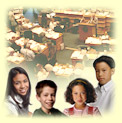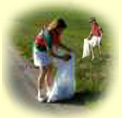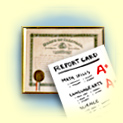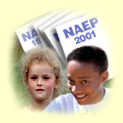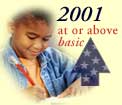|
|||||||||
Inside NAEP Archive
The Arts
 |
In 1997, 70 percent of eighth-graders reported that they were involved in live theatre acting in school. (NAEP 1997 arts assessment, Chapter 3, page 71.) |
| [ explore further ] |
|
|
In 1997, 22 percent of eighth-graders reported that they sang in a chorus or choir in school. (1997 NAEP arts assessment) |
| [ explore further— turn to chapter 2, page 40] | |
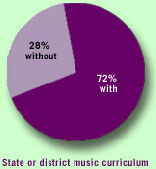 |
About three quarters of the students who participated in the 1997 arts assessment attended schools that reported having a district or state curriculum in music. (NAEP 1997 arts assessment) |
| [ explore further ] | |
Civics
|
One-half of the eighth-graders in the 1998 civics assessment demonstrated an understanding of the legislative power of Congress to override a presidential veto. (1998 NAEP civics assessment) |
| [ explore further ] | |
|
How many hours a week do twelfth-grade students work at a job for pay? (1998 NAEP civics assessment) |
| [ explore further ] | |
|
About one-third of all twelfth-graders surveyed in the NAEP civics assessment reported they volunteer on their own in their communities. (1998 NAEP civics assessment) | |
| [ explore further ] | ||
 |
Eighty-one percent of eighth-grade students understood that a law that requires segregation of the races is unjust. (1998 NAEP civics assessment) |
| [ explore further ] | |
 |
Sixty-six percent of fourth graders know what the pledge of allegiance means. (1998 NAEP civics assessment) |
| [ explore further ] | |
Geography
|
The percentage of eighth-grade students who studied maps and globes at least once or twice a week increased between 1994 and 2001 from about 39 percent to approximately 45 percent. (2001 NAEP geography assessment) |
| [ explore further ] | |
|
In 2001, the higher the parental education level reported, the higher the average score attained by eighth-graders. (2001 NAEP geography assessment) |
| [ explore further ] | |
|
In 2001, 26 percent of fourth-graders reported geography was one of their favorite subjects. (2001 NAEP geography assessment) |
| [ explore further ] | |
|
In 2001, three-quarters of fourth-graders reported using computers to look up information on the Internet. (2001 NAEP geography assessment) |
| [ explore further ] | |
|
71% of eighth-graders in the 2001 NAEP geography assessment correctly identified the Pacific as the world's largest ocean. |
| [ explore further ] | |
|
In the NAEP 2001 geography assessment, twenty-five percent of twelfth-graders were able to provide a response that included two valid reasons for tropical deforestation. |
| [ explore further ] | |
|
Twelfth-graders who used the Internet for research projects to a moderate or large extent had higher average scores on the NAEP 2001 geography assessment than those who used it to a small extent or not at all. |
| [ explore further ] | |
|
At grade 4, the average score for Black students on the NAEP 2001 geography assessment increased from 168 in 1994 to 181 in 2001. |
| [ explore further ] | |
|
At all three grades, boys had higher average scores than girls on the NAEP 2001 geography assessment. |
| [ explore further ] | |
|
In 2001, 30 percent of eighth-graders performed at or above the Proficient achievement level on the 2001 NAEP geography assessment. |
| [ explore further ] | |
|
Fourth- and eighth-graders had higher average scale scores in 2001 than in 1994 on the 2001 NAEP geography assessment. |
| [ explore further ] | |
Mathematics
| Half of fourth-graders able to solve temperature problem | |
![[Photo showing common mathematics tools]](/peth04/20041024190914im_/http://www.nces.ed.gov/nationsreportcard/images/home/stat_wk_math.jpg) |
One-half of fourth-graders could correctly calculate the number of degrees the temperature had risen by reading the information on a thermometer. (NAEP 2003 mathematics assessment) |
| [ explore further ] |
|
![[Photo showing common mathematics tools]](/peth04/20041024190914im_/http://www.nces.ed.gov/nationsreportcard/images/home/stat_wk_math.jpg) |
In 2003, at both grades 4 and 8, Asian/Pacific Islander students scored higher on average in mathematics than did White students. Explore scores by race/ethnic group. (NAEP 2003 mathematics assessment) |
![[Photo showing common mathematics tools]](/peth04/20041024190914im_/http://www.nces.ed.gov/nationsreportcard/images/home/stat_wk_math.jpg) |
Fifty-seven percent of eighth-graders correctly found the median of a group of numbers on the NAEP 2003 mathematics assessment. (NAEP 2003 mathematics assessment) |
| [ explore further ] |
|
![[Photo showing common mathematics tools]](/peth04/20041024190914im_/http://www.nces.ed.gov/nationsreportcard/images/home/stat_wk_math.jpg) |
Among eighth-graders who were eligible for free/reduced-price lunch, the percentages performing at or above Basic and at or above Proficient in mathematics increased between 2000 and 2003, and were higher in 2003 than in 1996. (NAEP 2003 mathematics assessment) |
| [ explore further ] |
|
![[Photo showing common mathematics tools]](/peth04/20041024190914im_/http://www.nces.ed.gov/nationsreportcard/images/home/stat_wk_math.jpg) |
Forty-seven percent of fourth-graders could find the length of one side of a square correctly when given the perimeter on the NAEP 2003 mathematics assessment. (NAEP 2003 mathematics assessment) |
| [ explore further ] |
|
| For the Same Mathematics Task, 51% of Fourth-Graders and 79% of Eighth-Graders Successful | |
![[A chart indicating that 51% of fourth-graders and 79% of eighth-graders correctly interpreted a pie chart.]](/peth04/20041024190914im_/http://www.nces.ed.gov/nationsreportcard/images/home/stat_wk_030504.jpg) |
In 2003, fifty-one percent of fourth-graders were able to correctly compute the number of hours represented by the whole pie chart when given the value for one sector. (NAEP 2003 mathematics assessment) |
| [ explore further ]
Seventy-nine percent of eighth-graders were able to complete the same task. |
|
| [ explore further ] |
|
| Nineteen Percent of Eighth-Graders Correctly Solve Problem Involving Two Linear Relationships, 2003 NAEP Mathematics | |
![[Chart showing results of eighth-graders solving a problem involving two linear relationships: 19% solved it correctly, 31% offered a partial solution, 41% gave an incorrect solution.]](/peth04/20041024190914im_/http://www.nces.ed.gov/nationsreportcard/images/home/stat_wk_021604.jpg) |
When presented with a problem involving rates of flow, 19 percent of eighth-graders solved it correctly, and 31 percent offered a partial solution in the NAEP 2003 mathematics assessment. Forty-one percent gave an incorrect solution. (NAEP 2003 mathematics assessment) |
| [ explore further ] |
|
| In Houston, New York City, and San Diego, Grade 4 Students' Scores Similar for 2003 Mathematics | |
![[Chart showing mathematics scale scores of students in Houston: 227, New York City: 226, San Diego: 226, and Large Central Cities: 224.]](/peth04/20041024190914im_/http://www.nces.ed.gov/nationsreportcard/images/home/stat_wk_020604.jpg) |
Compared with the average score in large central cities across the nation, the average scores in three districts (Houston, New York City, and San Diego) were not found to be significantly different, and the average scores in the remaining six districts were lower (NAEP 2003 Trial Urban District Assessment in mathematics) |
| [ explore further ] |
|
| Charlotte and New York City Students Outscore Students in Other Large Central Cities in Grade 8 Mathematics | |
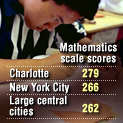 |
At grade 8, students in Charlotte and New York City scored higher, on average, than students in large central city public schools throughout the nation. The average scores for students in Boston, Houston, and San Diego were not found to be significantly different, while the scores for students in Atlanta, Chicago, Cleveland, the District of Columbia, and Los Angeles were lower. (NAEP 2003 Trial Urban District Assessment in mathematics) |
| [ explore further ] |
|
| Charlotte Outscores Nation, Other Large Central Cities in Grade 4 NAEP 2003 Mathematics | |
 |
At grade 4, average scores for students in Charlotte were higher than those for the nation, large central cities, and the other participating districts. (NAEP 2003 Trial Urban District Assessment in mathematics) |
| [ explore further ] |
|
| Mathematics Score Gaps Narrow from 2000 to 2003 | |
 |
At grade 4, the average mathematics score gaps between White and Black students and between White and Hispanic students narrowed between 2000 and 2003. (NAEP 2003 mathematics assessment) |
| [ explore further ] |
|
| Mathematics Average Scale Scores Higher in 2003 than in 1990 | |
 |
Average mathematics scores of both fourth- and eighth-grade students were higher in 2003 than in all the previous assessment years since 1990. (NAEP 2003 mathematics assessment) |
| [ explore further ] |
|
| Percentage of Black Fourth-Graders Scoring at or Above Basic in Mathematics Doubled | |
 |
The percentage of Black fourth-grade students at or above the Basic level in mathematics doubled from 19 percent in 1990 to 39 percent in 2000. (2000 NAEP mathematics assessment) |
| [ explore further ] |
|
 |
In 2000, more than half of twelfth-graders had teachers who reported replacing math textbooks every five to seven years. (2000 NAEP mathematics assessment) |
| [ explore further ] | |
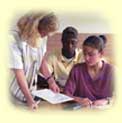 |
In 2000, 52 percent of twelfth-graders attended schools that required students to take and pass a district or state test in mathematics to graduate. |
| [ explore further ] | |
| National Mathematics Achievement-Level Results | ||
 |
The percentage of eighth-graders at or above the Proficient level in mathematics increased from 15 percent in 1990 to 27 percent in 2000. (2000 NAEP mathematics assessment) | |
| [ explore further ] | ||
| Characteristics of Highest Performing Students | |
 |
The highest performing students in the 2000 eighth-grade math assessment were more likely than the lowest performing students to attend a school in a suburban neighborhood. (NAEP 2000 Mathematics assessment) |
| [ explore further ] |
|
| Calculator Use and Student Achievement | |
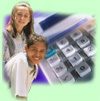 |
Eighth-graders whose teachers reported daily calculator use in class scored higher on the mathematics assessment than their peers whose teachers reported less frequent calculator use. (NAEP 2000 mathematics assessment) |
| [ explore further ] |
|
| Teachers' Training Related to Mathematics Achievement | |
 |
Eighth-grade students whose teachers majored in mathematics or mathematics education had higher average math scores than eighth-grade students whose teachers did not. (NAEP 2000 mathematics assessment) |
| [ explore further ] |
|
| Significant Gains for States | |
 |
27 of 31 states or jurisdictions made significant gains in eighth-graders' math scores between 1990 and 2000. (NAEP 2000 mathematics assessment) |
| [ explore further ] |
|
| Mathematics: Top Performing States | |
 |
The following states outperformed all other participating states at grade 4 on the NAEP 2000 mathematics assessment: Connecticut, Indiana, Iowa, Kansas, Massachusetts, Minnesota, North Carolina, Texas, Vermont. States shown in white did not participate at grade 4 in 2000. (NAEP 2000 mathematics assessment) |
| [ explore further ] |
|
| National Mathematics Results | |
 |
Scores up since 1990 for fourth-, eighth-, and twelfth-graders despite recent decline among high school seniors. (NAEP 2000 mathematics assessment) |
| [ explore further ] |
|
| Gains in States' Mathematics Scores | |
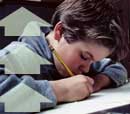 |
Gains shown in 26 of 36 participating states in fourth-grade scores since 1992. Gains also shown in 27 of 31 participating states in eighth-grade scores since 1990. (NAEP 2000 mathematics assessment) |
| [ explore further ] | |
Reading
| Atlanta eighth-grade students improve scores in 2003 reading assessment | |
![[Photo showing various reading materials]](/peth04/20041024190914im_/http://www.nces.ed.gov/nationsreportcard/images/home/stat_wk_reading.jpg) |
At grade 8, the average reading score for students in Atlanta''s public schools increased between 2002 and 2003. Explore other districts' scores further. (NAEP 2003 Trial Urban District Assessment in reading) |
| Asian/Pacific Islander and White Students Score Higher in Reading Than Other Groups | |
![[Photo showing various reading materials]](/peth04/20041024190914im_/http://www.nces.ed.gov/nationsreportcard/images/home/stat_wk_reading.jpg) |
The average reading scores for White students and Asian/Pacific Islander students in 2003 were higher on average than for Black, Hispanic, and American Indian students at both grades 4 and 8 in 2003. Explore scores by race/ethnic group. (NAEP 2003 reading assessment) |
![[Photo showing various reading materials]](/peth04/20041024190914im_/http://www.nces.ed.gov/nationsreportcard/images/home/stat_wk_reading.jpg) |
"Eighty-four percent of eighth-graders correctly chose the answer that best describes a character's motivation at a particular point in the story "Thank you, M'am," by Langston Hughes." (NAEP 2003 reading assessment) |
| [ explore further ] |
|
![[Photo showing various reading materials]](/peth04/20041024190914im_/http://www.nces.ed.gov/nationsreportcard/images/home/stat_wk_reading.jpg) |
The percentages of White and Black eighth-graders at or above Proficient in reading were higher in 2003 than in 1992.
(NAEP 2003 reading assessment) |
| [ explore further ] |
|
![[Photo showing various reading materials]](/peth04/20041024190914im_/http://www.nces.ed.gov/nationsreportcard/images/home/stat_wk_041904.jpg) |
In the NAEP 2003 reading assessment, students were asked to use what they learned about wombats' temperament from the article "Watch Out for Wombats" to infer how a wombat might respond to humans. Seventy-six percent of fourth-graders answered this question correctly. (NAEP 2003 reading assessment) |
| [ explore further ] |
|
| Sixty-One Percent of Twelfth-Graders Show Understanding of 1961 Vast Wasteland Speech | |
![[Photo: portion of written response by twelfth-grader.]](/peth04/20041024190914im_/http://www.nces.ed.gov/nationsreportcard/images/home/stat_wk_031204.jpg) |
Twelfth-graders read Newton Minow's vast wasteland speech and were asked how the author suggested solving problems in children's television programming. Sixty-one percent of the students showed evidence of full comprehension, while twenty-seven percent showed evidence of little or no comprehension. (NAEP 2002 reading assessment) |
| [ explore further ] |
|
| Twenty-Eight Percent of Fourth-Graders Successfully Analyzed Important Aspect of Short Story They Read | |
![[Photo: portion of written response by fourth-grader.]](/peth04/20041024190914im_/http://www.nces.ed.gov/nationsreportcard/images/home/stat_wk_022704.jpg) |
Fourth-graders were asked to read a story and describe one of the most important lessons learned by the main characters in the story. Of the answers, 28 percent were rated as showing evidence of full comprehension and 49 percent showed partial or surface comprehension. (NAEP 2003 reading assessment) |
| [ explore further ] |
|
| More Chicago and Atlanta Students Achieve At or Above Proficient in 2003 Compared to 2002 | |
![[Chart showing sample percentages of students at or above 'Proficient'. Chicago, grade 4: 11% in 2002, 14% in 2003. Atlanta, grade 8: 8% in 2002, 11% in 2003.]](/peth04/20041024190914im_/http://www.nces.ed.gov/nationsreportcard/images/home/stat_wk_013004.jpg) |
Among the five urban districts that participated in both 2002 and 2003, the percentages of public school students at or above Proficient in reading were found to be significantly higher in 2003 for students in Chicago at grade 4, and for students in Atlanta at grade 8. (NAEP 2003 Trial Urban District Assessment in reading) |
| [ explore further ] |
|
| More Fourth-Graders Achieve At or Above Proficient in Reading in Large Central Cities | |
 |
At grade 4, the percentage of students at or above Proficient in reading in large central city public schools was found to be significantly higher in 2003 than in 2002. (NAEP 2003 Trial Urban District Assessment in reading) |
| [ explore further ] |
|
| Chicago Reading Scores Increase in 2003 | |
 |
Average reading scores for fourth-graders in Chicago public schools increased between the 2002 and 2003 assessments. (NAEP 2003 Trial Urban District Assessment in reading) |
| [ explore further ] |
|
| Females Outscore Males in NAEP 2003 Reading | |
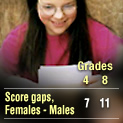 |
In 2003, female students continue to score higher than male students in reading, by 7 points at grade 4, and by 11 points at grade 8. (NAEP 2003 reading assessment) |
| [ explore further ] |
|
| Jurisdictions At or Above Proficient Level in Reading Compared to Nation | |
 |
In 2003, 25 of the 53 states and other jurisdictions that participated in the eighth-grade reading assessment had higher percentages of students at or above Proficient than the nation as a whole. (NAEP 2003 reading assessment) |
| [ explore further ] |
|
 |
Fourth-graders in 15 states and other jurisdictions had higher average reading scores in 2002 than in 1992.
(NAEP 2002 reading assessment) |
| [ explore further ] |
|
 |
The average reading score gap between male and female eighth-graders has narrowed since 1992, while the twelfth-grade gap has widened. (NAEP 2002 reading assessment) |
| [ explore further ] |
|
 |
In 2002, eighth-graders in Chicago and Houston had higher average reading scores than students in Atlanta, the District of Columbia, or Los Angeles. (NAEP 2002 Reading Trial Urban District Assessment) |
| [ explore further ] |
|
 |
In 2002, the percentage of fourth-graders performing at or above Proficient on the reading assessment ranged from 10 to 19% in six urban districts, while the percentage performing at or above Proficient was 30% for the nation. (NAEP 2002 Reading Trial Urban District Assessment) |
| [ explore further ] |
|
 |
In 2002, fourth-graders in New York City and Houston had higher average reading scores than those in Atlanta, Chicago, the District of Columbia, and Los Angeles. (NAEP 2002 Trial Urban District Assessment) |
| [ explore further ] |
|
|
The percentage of 4th- and 8th-graders who performed at or above the Proficient level in reading was higher in 2002 than in 1992, while the 12th-grade percentage at this level was lower. (NAEP 2002 reading assessment) |
| [ explore further ] | |
|
White, Black, and Hispanic eighth-graders had higher average reading scores in 2002 than in 1992. (NAEP 2002 reading assessment) |
| [ explore further ] | |
|
Almost two out of three of fourth-graders read 11 or more pages a day for school and homework. (NAEP 2000 reading assessment) |
| [ explore further ] | |
|
A larger percentage of fourth-grade students performed at or above the Proficient level in the NAEP 2000 reading assessment (about 32 percent) than in the 1992 assessment (about 29 percent). (NAEP 2000 reading assessment) |
| [ explore further ] | |
|
The average reading score among fourth-graders in the Northeast was higher in 2000 than in 1994. In the Central, Southeast, and West regions, no change occurred in the average score between 1994 to 2000. (NAEP 2000 reading assessment) |
| [ explore further ] | |
|
In 2000, 62 percent of fourth-graders attended schools that either occasionally or routinely involved parents as guest teachers. (2000 NAEP reading assessment) |
| [ explore further ] | |
 |
Fourth-grade students who reported watching three or fewer hours of TV each day outperformed their peers on the NAEP reading assessment. (2000 NAEP reading assessment) |
| [ explore further ] |
|
 |
Almost two out of three of fourth-graders read 11 or more pages a day for school and homework. (NAEP 2000 reading assessment) |
| [ explore further ] |
|
 |
Fourth-grade female students continue to score higher than their male counterparts in reading. (NAEP 2000 reading assessment) |
| [ explore further ] |
|
 |
The percentage of fourth-grade students performing at or above the proficient level in reading has increased since 1992. (NAEP 2000 reading assessment) |
| [ explore further ] |
|
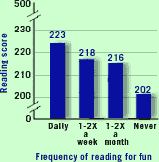 |
Fourth-grade students who read for fun daily had the highest reading scores. (NAEP 2000 reading assessment) |
| [ explore further ] | |
Science
|
When asked, 66 percent of eighth-graders identified the stomach and small intestines as the two organs in which digestion of protein takes place. (2000 NAEP science assessment) |
| [ explore further ] | |
 |
In 2000, 53 percent of eighth-grade students had teachers who used computers (e.g., science software, telecommunications) at least once or twice a month for teaching science. (2000 NAEP science assessment) |
| [ explore further ] | |
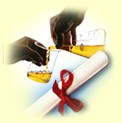 |
In 2000, less than one-quarter of twelfth-graders attended schools that required students to take and pass a district or state test in science to graduate. (2000 NAEP science assessment) |
| [ explore further ] | |
 |
In the 2000 science assessment, 29 percent of twelfth-graders were able to draw and label a model of an atom. |
| [ explore further ] | |
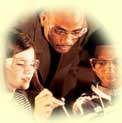 |
Students who reported participating in a science fair, festival, or special science day had higher scores on the 2000 science assessment than those who did not. |
| [ explore further ] | |
 |
Students in grades 4, 8, and 12 who reported using the Internet at home had higher average scores on the 2000 science assessment than those indicating they did not use the Internet. |
| [ explore further ] | |
| Science Projects and Performance | |
 |
Twelfth-grade students who performed hands-on science activities or investigations at least once or twice a month performed better on the NAEP 2000 science assessment than students who never or hardly ever did. (NAEP 2000 science assessment) |
| [ explore further ] |
|
| Science Projects and Performance | |
 |
Fourth-graders whose teachers assigned science projects that took a week or more scored higher on the NAEP 2000 science assessment. (NAEP 2000 science assessment) |
| [ explore further ] |
|
| Internet Use and Science Performance | |
 |
Eighth-graders who reported using the Internet at home scored higher on the NAEP 2000 science assessment. (NAEP 2000 science assessment) |
| [ explore further ] |
|
| Science Score Gaps Increase | |
 |
Gaps in average science scores favoring males over females have widened since 1996 in grades 4 and 8. (NAEP 2000 science assessment) |
| [ explore further ] |
|
| State Performance on NAEP Science | |
 |
Average science scores for eighth-graders in 18 states and other jurisdictions were above the national average. (NAEP 2000 science assessment) |
| [ explore further ] |
|
| State Performance on NAEP Science | |
 |
Average science scores for fourth-graders in 20 states and other jurisdictions were above the national average. (NAEP 2000 science assessment) |
| [ explore further ] |
|
 |
Eighth-grade students who were not expected to do homework on a weekly basis scored lower than those who were. (NAEP 1996 science assessment) |
| [ explore further ] | |
U.S. History
|
At grade 4, the gap in average scores between White and Black students on the NAEP U.S. history assessment was smaller in 2001 (approximately 31 scale score points) than in 1994 (38 points). (NAEP 2001 U.S. history assessment) |
| [ explore further ] | |
|
Thirty percent of twelfth-graders identified the composition of the North Atlantic Treaty Organization and Warsaw Pact. (2001 NAEP U.S. history assessment) |
| [ explore further ] | |
|
Thirty percent of twelfth-graders identified the composition of the North Atlantic Treaty Organization and Warsaw Pact. (2001 NAEP U.S. history assessment) |
| [ explore further ] | |
|
In 2001, 41 percent of twelfth-graders identified the purpose of Upton Sinclair's novel The Jungle as describing the terrible working and food production conditions in the meatpacking industry. (2001 NAEP U.S. history assessment) |
| [ explore further ] | |
|
Forty percent of twelfth-graders correctly identified the purpose of British colonial mercantilism. (2001 NAEP U.S. history assessment) |
| [ explore further ] | |
|
When studying social studies in school, about 45 percent of eighth-graders used computer programs in which they played the role of explorers, geographers, anthropologists, or historians to at least some extent. (2001 NAEP U.S. history assessment) |
| [ explore further ] | |
|
Forty-six percent of fourth-graders correctly identified the source of this passage. (2001 NAEP U.S. history assessment) |
| [ explore further ] | |
|
In the 2001 U.S. history assessment, 54 percent of fourth-graders were able to accurately identify early American slave trade routes on a map. (2001 NAEP U.S. history assessment) |
| [ explore further ] |
|
|
30 percent of eighth-graders in the 2001 U.S. history assessment correctly identified the Knights of Labor as one of America's first labor unions. |
| [ explore further ] | |
|
Fourth-graders whose teachers spent more than 180 minutes per week on social studies had higher average scores on the U.S. history assessment than students whose teachers spent less time. |
| [ explore further ] | |
|
In 2001, fourth-graders whose teachers asked them to read from a textbook on a daily basis had higher average scores on the U.S. history assessment than students whose teachers did so on a weekly or monthly basis. |
| [ explore further ] | |
|
Eighth- and twelfth-graders who reported using CDs or the Internet to a greater extent to do research projects scored higher on the U.S. history assessment than those who spent less time on these activities. |
| [ explore further ] | |
|
At grade 12, the higher the level of parental education, the higher the average score obtained by students. (2001 NAEP U.S. history assessment) |
| [ explore further ] | |
|
Average U.S. history scores of eighth-grade males were higher in 2001 than in 1994. (2001 NAEP U.S. history assessment) |
| [ explore further ] | |
|
The percentage of eighth-graders performing at or above Basic, at or above Proficient, and at Advanced in U.S. history increased between 1994 and 2001. (2001 NAEP U.S. history assessment) |
| [ explore further ] | |
|
At grade 4, Black students had higher percentages at or above Basic in 2001 compared to 1994. (2001 NAEP U.S. history assessment) |
| [ explore further ] | |
| "A house divided against itself cannot stand. I believe this government cannot endure permanently half slave and half free..." | About three in five eighth-graders (59 percent) and two in five fourth-graders (39 percent) could correctly identify the author of this speech. (1994 NAEP U.S. history assessment) |
| [ explore further ] | |
Writing
 |
In 2002, female students had higher average writing scores than male students at grades 4, 8, and 12. (NAEP 2002 writing assessment) |
| [ explore further ] |
|
 |
At grade 8, the average writing scores for students in the nation and for central city public schools generally were higher than those in urban districts assessed, except in Houston, where average scores were not significantly different from central cities. (NAEP 2002 Trial Urban District Assessment in writing) |
| [ explore further ] |
|
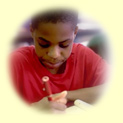 |
In 2002, the percentage of eighth-graders performing at or above the Proficient level in writing increased since 1998. (NAEP 2002 writing assessment) |
| [ explore further ] |
|
 |
Gains in writing were made among higher-performing twelfth-graders between 1998 and 2002, but average scores of lower-performing twelfth-graders declined. (NAEP 2002 writing assessment) |
| [ explore further ] |
|
 |
In 2002, Asian/Pacific Islander students outperformed all other race/ethnic subgroups in writing at grade 4. (NAEP 2002 writing assessment) |
| [ explore further ] |
|
 |
In 2002, the percentage of fourth-graders performing at or above Proficient on the writing assessment ranged from 11-27% in six urban districts, while the percentage performing at or above Proficient was 27% for the nation.. (NAEP 2002 writing assessment) |
| [ explore further ] |
|
 |
In 2002, eighth-graders in Houston had higher average writing scores than students in Atlanta, the District of Columbia, and Los Angeles but were not statistically different from students in Chicago. (NAEP 2002 writing assessment) |
| [ explore further ] | |
 |
Higher-performing twelfth-graders made gains in writing between 1998 and 2002, but average scores of lower-performing twelfth-graders declined. (NAEP 2002 writing assessment) |
| [ explore further ] |
|
 |
The average writing scores of eighth-graders increased in 16 states and other jurisdictions between 1998 and 2002. (NAEP 2002 writing assessment) |
| [ explore further ] |
|
 |
In 1998, Asian/Pacific Islander students outperformed all other race/ethnic subgroups in writing at grade 4. (NAEP 1998 writing assessment) |
| [ explore further ] |
|
Long-Term Trend
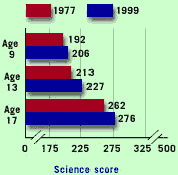 |
Hispanic students at ages 9, 13, and 17 had higher science scores in 1999 than in 1977. (NAEP 1999 long-term trend assessment) |
| [ explore further ] | |
High School Transcript Study
 |
Graduates who earned Advanced Placement (AP) or International Baccalaureate (IB) mathematics course credits performed better on the NAEP 2000 mathematics assessment (345) than graduates who earned neither AP nor IB mathematics course credits (297). There were similar findings for the NAEP science assessment. (NAEP 2000 High School Transcript Study) |
| [explore mathematics (10K PDF) and science (11K PDF)] |
|
 |
Graduates in each racial/ethnic subgroup increased the number of course credits earned, and attained an increase in overall grade point average from 1990-2000. (NAEP 2000 High School Transcript Study) |
| [ explore further ] | |

